The Art of Charcuterie: A Journey Through Flavors
Charcuterie, the French culinary tradition of preparing and assembling cured meats and other meat products, is gaining momentum worldwide. This article delves into the world of charcuterie, exploring its history, techniques, and modern innovations, and how you can bring this culinary tradition to your own table.

A Taste of History
Charcuterie is deeply rooted in French gastronomy. Its origins trace back to the 15th century when butchers started to specialize in pork preparation. The term “charcuterie” was coined from the French words for flesh (‘chair’) and cooked (‘cuit’). Originally, charcuterie was a way to preserve meats before the advent of refrigeration. Today, it is celebrated as an art form that brings together a variety of flavors and textures.
The Building Blocks of Charcuterie
At its core, charcuterie involves a range of techniques including salting, smoking, fermenting, and curing to create a variety of meat products. The most familiar are sausages, salami, ham, and pâté. But there are also lesser-known but equally delightful treats like bresaola (air-dried, salted beef), rillettes (meat slowly cooked in fat until it can be spread), and terrines (coarse, rustic pâté). Each component offers a different taste and texture, contributing to an overall balanced charcuterie board.
The Modern Charcuterie Board
While traditional charcuterie focused on pork, modern charcuterie boards have expanded to include a variety of meats, cheeses, pickles, fruits, and bread. The aim is to create a visually appealing and balanced platter of flavors - sweet, salty, sour, and umami. The modern charcuterie board is as much about presentation as it is about taste.
Innovation in Charcuterie
Innovation is at the heart of the culinary world, and charcuterie is no exception. Chefs are experimenting with different types of meat, incorporating game meats like venison and duck, and even fish. Non-meat alternatives, such as vegan sausages and cheeses, are also gaining popularity, offering a new dimension to the traditional charcuterie board.
A Charcuterie Board at Home
Creating a charcuterie board at home can seem intimidating, but it’s easier than you think. Start with a variety of meats and cheeses, add some pickles and olives for acidity, include fresh fruits and nuts for contrast, and don’t forget the bread or crackers. The key is to experiment and find what flavors and textures you enjoy most.
Tips to Enhance Your Charcuterie Experience
- Try to include a variety of textures and flavors on your board - creamy, crunchy, salty, sweet, and tart.
- Experiment with different types of bread - baguette, sourdough, and rye all offer different tastes.
- Don’t be afraid to try new things - unusual cheeses or meats can bring an interesting twist to your board.
- Presentation matters - arrange your board in a way that is appetizing and visually appealing.
In conclusion, charcuterie offers a unique blend of history, culinary skill, and creativity. Whether you’re a seasoned foodie or a culinary novice, there’s something to enjoy in the art of charcuterie. The possibilities are limitless, and the end result is not just a meal, but a culinary experience that engages all the senses.




